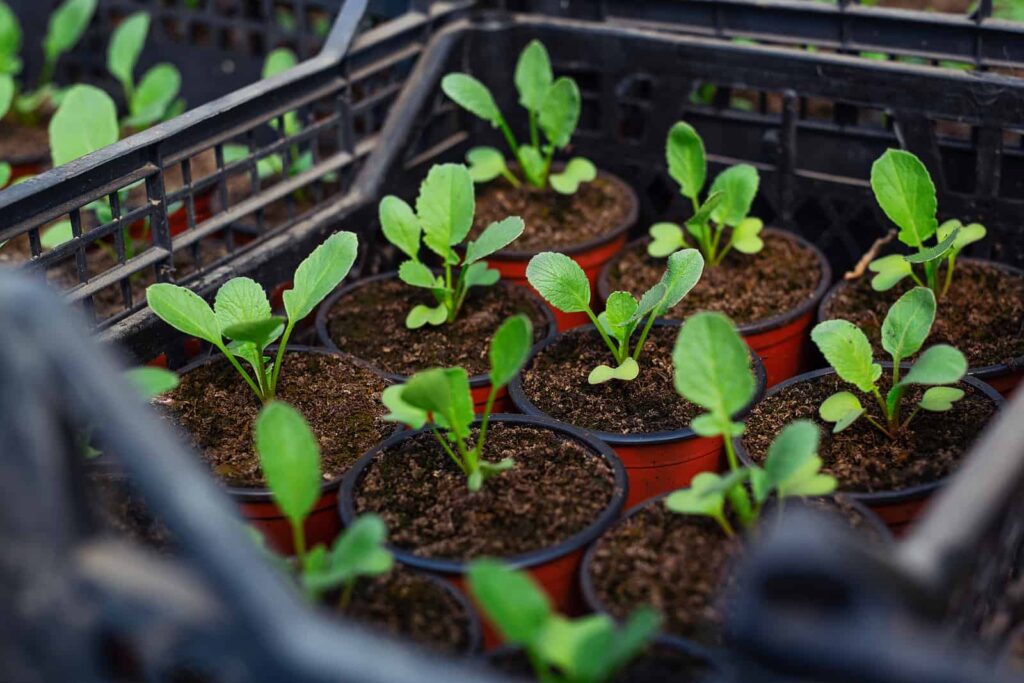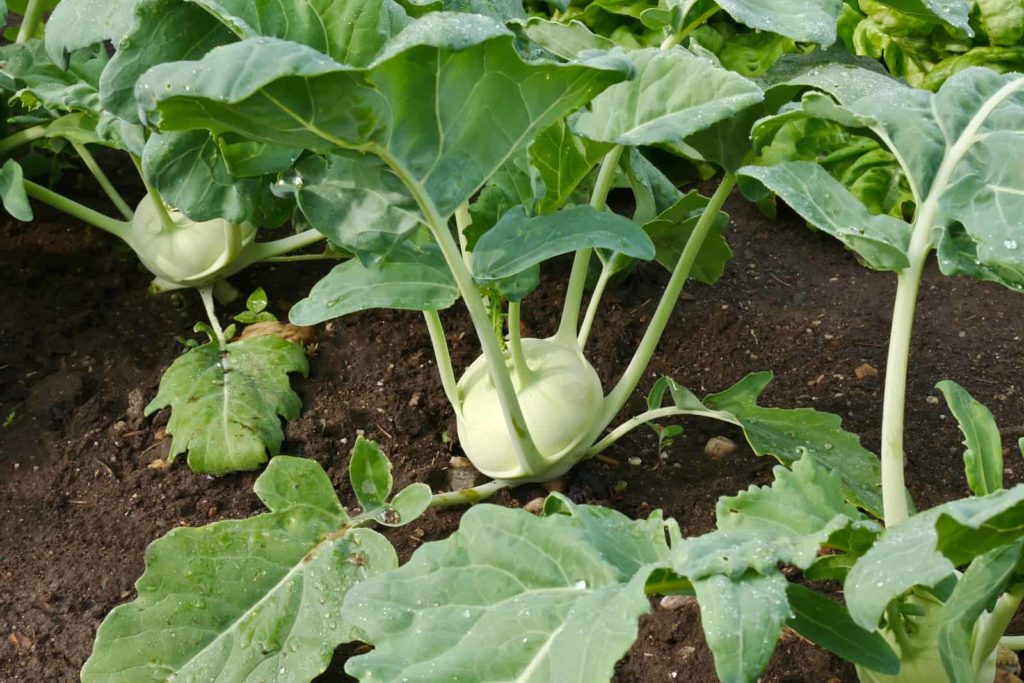Kohlrabi is a cool-season crop; it’s best grown in spring and fall. Sow kohlrabi in spring for an early summer harvest and use; start a second crop in mid-to-late summer for winter storage and use.
Kohlrabi is not a root crop; the edible part of the plant is a swollen portion of the stem growing above the soil. Kohlrabi matures in 45 to 60 days depending on the variety.
Sow kohlrabi seeds in the garden 4 to 6 weeks before the last frost. Sow seeds indoors for transplanting out 6 to 8 weeks before setting them in the garden.
Kohlrabi articles at Harvest to Table:
- How to Plant and Grow Kohlrabi
- Kohlrabi Seed Starting Tips
- How to Harvest and Store Kohlrabi
- Turnip, Rutabaga, and Kohlrabi Growing Problem Troubleshooting
- Ten Ways to Cook and Serve Kohlrabi
- Kohlrabi Puree Side Dish
Set kohlrabi transplants in the garden 5 weeks before to 2 weeks after the last frost. Make succession plantings every two weeks until mid-June.
Kohlrabi matures in 50 to 70 days after seeds are sown. Harvest kohlrabi while still small, no more than 2 to 3 inches (5-8cm) in diameter. Slice through the stem 1 inch below the bulb.

Kohlrabi prefers humus-rich soil and full sun, but kohlrabi can tolerate partial shade. Kohlrabi is a heavy feeder that needs high amounts of potassium for the best growth.
Time late summer planting so that kohlrabi is touched by frost before harvest in autumn; frost will sweeten the flavor of kohlrabi.
Kohlrabi can be eaten raw or cooked, and it stores well for winter use. To be tender and tasty, kohlrabi must be grown quickly and without interruption. It’s important to keep the soil just moist and grow kohlrabi in soil rich in organic matter and aged compost.
Kohlrabi planting details
- Sowing depth: ¼ inch (6mm)
- Space between plant after thinning: 6-9 inches (10-23cm)
- Days to sprout: 5-10
- Days to harvest: 50-60
- Storage period: 2-4 weeks
- Seeds per 100-row feet: ½ ounce (14 grams)
- Yield per 100-row feet: 100 pounds (45kg)
- Varieties: Early White Vienna, Grand Duke, Purple Vienna

Kohlrabi sowing and planting tips
- Start kohlrabi from seed sown indoors or directly in the garden.
- Kohlrabi seeds are viable for 4 years.
- Start seeds in the garden about 8 to 4 weeks before you expect the last frost.
- If started indoors and transplanted, allow two additional weeks to maturity as a result of root insult at transplanting; nip off the long thread tip of the root when transplanting.
- Sow seed ¼ to ½ (6-12 mm) inches deep and be sure to heel or stamp the soil firmly.
- Sow seed 2 inches (5 cm) apart and later thin to 5 to 8 inches (13-20 cm) in all directions.
- To improve germination sow seed at dusk or on a cool, cloudy day.
- Sow seed in loose, fertile soil. Adding aged compost to planting beds in advance of sowing will feed the soil and aid moisture retention.
- Seeds should germinate in 5 to 10 days at an optimal temperature of 70°F (21C) or thereabouts; germination will take longer in colder soil.
- Optimum soil temperature to grow kohlrabi is 65°F (18°C).
- Make additional sowing at 3-week intervals for a continuous harvest, but time sowing so that the crop does not mature in hot weather.
- Kohlrabi prefers a soil pH range of 5.5 to 6.8.
- Grow kohlrabi in full sun for best yield—tolerates partial shade.
- Fertilize with an organic fertilizer such as fish emulsion at half strength.
- Common pest enemies include aphids, flea beetles, cabbage root maggots, cabbage worms, and cabbage loopers.
- Protect the seedlings from pests and cold weather for two to three weeks after planting with spun poly-row covers.
More tips at How to Grow Kohlrabi.
Interplanting: Plant kohlrabi with bush beans, beets, celery, cucumbers, lettuce, and onions.
Container growing: Choose a container 6 inches across or more for each plant and 8 inches deep.
Kohlrabi planting calendar
Planting for late spring harvest:
- 6-8 weeks before the last frost in spring: direct sow seed in a plastic tunnel or cold frame; minimum soil temperature should be 50°
- 3-4 weeks before the last frost in spring: direct sow seed in the garden; minimum soil temperature should be 50°F; protect seedlings with row covers.
- 2-3 weeks before the last frost in spring: transplant seedlings to the garden.
Planting for fall and winter harvest:
- 12-14 weeks before the first frost in fall: start seed indoors.
- 10-12 weeks before the first frost in fall: direct-sow seed in the garden for fall harvest.
- 8-10 weeks before the first frost in fall: direct-sow seed in a plastic tunnel or cold frame.
- 6-8 weeks before the first frost in fall: transplant seedlings to the garden.

Kohlrabi seed sowing dates
(These dates are for the Northern Hemisphere)
| Average date of the last frost | Planting dates |
| Jan. 30 | Jan. 1-Feb. 1 |
| Feb. 8 | Jan. 10-Feb. 1 |
| Feb. 18 | Jan. 20-Feb. 10 |
| Feb. 28 | Feb. 1-20 |
| Mar. 10 | Feb. 10-Mar. 1 |
| Mar. 20 | Feb. 20-Mar. 10 |
| Mar. 30 | Mar. 1-20 |
| Apr. 10 | Mar. 10-Apr. 10 |
| Apr. 20 | Mar. 20-May 1 |
| Apr. 30 | Apr. 1-May 10 |
| May 10 | Apr. 10-May 15 |
| May 20 | Apr. 20-May 10 |
| May 30 | May 1-30 |
| June 10 | May 15-June 1 |
Good Products for Growing Kohlrabi at Amazon:
- Garden Safe Snail and Slug Bait
- Bonide Sulfur Fungicide
- Monterey BT Caterpillar Killer
- Neem Bliss 100-% Cold Pressed Neem Oil
- PyGanic Botanical Insecticide
Kohlrabi recommended varieties
- ‘Rapid’ matures early.
- ‘Grand Duke’ is a midseason hybrid.
- ‘Purple Danube’ and ‘Purple Vienna’ are favorites.
Botanical Name: Brassica oleracea var. gongylodes
Kohlrabi belongs to the Brassicacea (Cruciferae) or cabbage family, other members include cabbage, kale, collard, broccoli, Brussels sprouts, and turnips.
Kohlrabi articles at Harvest to Table:
How to Plant and Grow Kohlrabi
How to Harvest and Store Kohlrabi
Turnip, Rutabaga, and Kohlrabi Growing Problem Troubleshooting
Ten Ways to Cook and Serve Kohlrabi
Garden Planning Books at Amazon:
- Vegetable Garden Grower’s Guide
- Tomato Grower’s Answer Book
- Vegetable Garden Almanac & Planner
- Kitchen Garden Grower’s Guide Vegetable Encyclopedia















